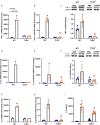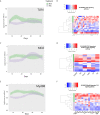Extracellular CIRP Induces an Inflammatory Phenotype in Pulmonary Fibroblasts via TLR4
- PMID: 34367191
- PMCID: PMC8342891
- DOI: 10.3389/fimmu.2021.721970
Extracellular CIRP Induces an Inflammatory Phenotype in Pulmonary Fibroblasts via TLR4
Abstract
Extracellular cold-inducible RNA-binding protein (eCIRP), a new damage-associated molecular pattern (DAMP), has been recently shown to play a critical role in promoting the development of bleomycin-induced pulmonary fibrosis. Although fibroblast activation is a critical component of the fibrotic process, the direct effects of eCIRP on fibroblasts have never been examined. We studied eCIRP's role in the induction of inflammatory phenotype in pulmonary fibroblasts and its connection to bleomycin-induced pulmonary fibrosis in mice. We found that eCIRP causes the induction of proinflammatory cytokines and differentially expression-related pathways in a TLR4-dependent manner in pulmonary fibroblasts. Our analysis further showed that the accessory pathways MD2 and Myd88 are involved in the induction of inflammatory phenotype. In order to study the connection of the enrichment of these pathways in priming the microenvironment for pulmonary fibrosis, we investigated the gene expression profile of lung tissues from mice subjected to bleomycin-induced pulmonary fibrosis collected at various time points. We found that at day 14, which corresponds to the inflammatory-to-fibrotic transition phase after bleomycin injection, TLR4, MD2, and Myd88 were induced, and the transcriptome was differentially enriched for genes in those pathways. Furthermore, we also found that inflammatory cytokines gene expressions were induced, and the cellular responses to these inflammatory cytokines were differentially enriched on day 14. Overall, our results show that eCIRP induces inflammatory phenotype in pulmonary fibroblasts in a TLR4 dependent manner. This study sheds light on the mechanism by which eCIRP induced inflammatory fibroblasts, contributing to pulmonary fibrosis.
Keywords: bleomicyn; eCIRP; fibroblast; fibrosis; inflammation.
Copyright © 2021 Bolourani, Sari, Brenner and Wang.
Conflict of interest statement
The authors declare that the research was conducted in the absence of any commercial or financial relationships that could be construed as a potential conflict of interest.
Figures







Similar articles
-
Extracellular CIRP decreases Siglec-G expression on B-1a cells skewing them towards a pro-inflammatory phenotype in sepsis.Mol Med. 2021 May 31;27(1):55. doi: 10.1186/s10020-021-00318-y. Mol Med. 2021. PMID: 34058975 Free PMC article.
-
Extracellular CIRP (eCIRP) and inflammation.J Leukoc Biol. 2019 Jul;106(1):133-146. doi: 10.1002/JLB.3MIR1118-443R. Epub 2019 Jan 15. J Leukoc Biol. 2019. PMID: 30645013 Free PMC article. Review.
-
Extracellular CIRP promotes Kupffer cell inflammatory polarization in sepsis.Front Immunol. 2024 May 30;15:1411930. doi: 10.3389/fimmu.2024.1411930. eCollection 2024. Front Immunol. 2024. PMID: 38881891 Free PMC article.
-
Cold-inducible RNA-binding protein (CIRP) in inflammatory diseases: Molecular insights of its associated signalling pathways.Scand J Immunol. 2021 Jan;93(1):e12949. doi: 10.1111/sji.12949. Epub 2020 Sep 8. Scand J Immunol. 2021. PMID: 32738154 Review.
-
m6A reader IGF2BP1 facilitates macrophage glycolytic metabolism and fibrotic phenotype by stabilizing THBS1 mRNA to promote pulmonary fibrosis.Cell Mol Life Sci. 2025 Apr 12;82(1):157. doi: 10.1007/s00018-025-05673-1. Cell Mol Life Sci. 2025. PMID: 40220148 Free PMC article.
Cited by
-
Exosome-derived CIRP: An amplifier of inflammatory diseases.Front Immunol. 2023 Feb 14;14:1066721. doi: 10.3389/fimmu.2023.1066721. eCollection 2023. Front Immunol. 2023. PMID: 36865547 Free PMC article. Review.
-
Targeting extracellular CIRP with an X-aptamer shows therapeutic potential in acute pancreatitis.iScience. 2023 Jun 7;26(7):107043. doi: 10.1016/j.isci.2023.107043. eCollection 2023 Jul 21. iScience. 2023. PMID: 37360693 Free PMC article.
-
The role of Cold-Inducible RNA-binding protein in respiratory diseases.J Cell Mol Med. 2022 Feb;26(4):957-965. doi: 10.1111/jcmm.17142. Epub 2021 Dec 24. J Cell Mol Med. 2022. PMID: 34953031 Free PMC article. Review.
-
An eCIRP inhibitor attenuates fibrosis and ferroptosis in ischemia and reperfusion induced chronic kidney disease.Mol Med. 2025 Jan 10;31(1):11. doi: 10.1186/s10020-025-01071-2. Mol Med. 2025. PMID: 39794717 Free PMC article.
-
Regulation of CIRP by genetic factors of SP1 related to cold sensitivity.Front Immunol. 2022 Sep 16;13:994699. doi: 10.3389/fimmu.2022.994699. eCollection 2022. Front Immunol. 2022. PMID: 36189232 Free PMC article.
References
Publication types
MeSH terms
Substances
Grants and funding
LinkOut - more resources
Full Text Sources
Medical
Molecular Biology Databases

